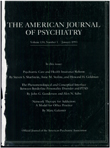Clozapine and norclozapine plasma concentrations and clinical response of treatment-refractory schizophrenic patients [published erratum appears in Am J Psychiatry 1991 Oct;148(10):1427]
Abstract
OBJECTIVE: Clozapine, an atypical antipsychotic, has been estimated to be effective in 30% of treatment-refractory schizophrenic patients. The authors hypothesized that if a dose-response relationship was obvious for this drug, the response rate could be significantly amplified. METHOD: Following an 8-24-day dose titration phase, 29 inpatients with treatment-resistant schizophrenia diagnosed according to DSM-III-R were given a clozapine dose of approximately 400 mg/day for 4 weeks; blood samples were obtained weekly during this period. RESULTS: A receiver operator curve demonstrated that the threshold clozapine plasma concentration for therapeutic response was 350 ng/ml. Sixty-four percent of the patients with clozapine plasma concentrations greater than 350 ng/ml responded, whereas only 22% of the patients with concentrations less than 350 ng/ml responded. CONCLUSIONS: Use of clozapine blood levels as a predictor for treatment response in treatment-refractory schizophrenic patients appears worthwhile, since the measurement's sensitivity for response was 64% and the specificity for nonresponse was 78%.
Access content
To read the fulltext, please use one of the options below to sign in or purchase access.- Personal login
- Institutional Login
- Sign in via OpenAthens
- Register for access
-
Please login/register if you wish to pair your device and check access availability.
Not a subscriber?
PsychiatryOnline subscription options offer access to the DSM-5 library, books, journals, CME, and patient resources. This all-in-one virtual library provides psychiatrists and mental health professionals with key resources for diagnosis, treatment, research, and professional development.
Need more help? PsychiatryOnline Customer Service may be reached by emailing [email protected] or by calling 800-368-5777 (in the U.S.) or 703-907-7322 (outside the U.S.).



